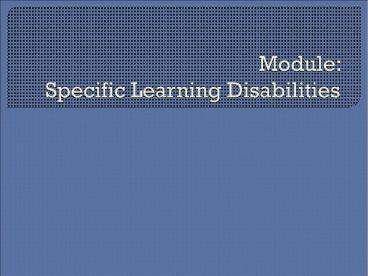Module: Specific Learning Disabilities PowerPoint PPT Presentation
Title: Module: Specific Learning Disabilities
1
Module Specific Learning Disabilities
2
Disability Categories
3
Specific Learning Disabilities
- A disorder in one or more of the basic
psychological processes involved in understanding
or using spoken or written language. - This disorder may manifest itself in an imperfect
ability to listen, think, read, write, spell,
and/or to perform mathematical calculations.
4
In determining the existence of a specific
learning disability, the following must be
examined
5
Characteristics
- Academic problems
- Disorders of attention
- Poor motor abilities
- Psychological process deficits and
information-processing problems - Lack of cognitive strategies needed for efficient
learning - Oral language difficulties
- Reading difficulties
- Written language problems
- Mathematical disorders
- Social skill deficits.
6
Impact on Learning
7
Perception
8
Attention
9
Memory
10
Metacognition
11
Organization
12
Five Cognitive Processess
13
Academic Achievement
- Reading
- Language
- Math
14
Reading
15
Language Arts
16
Math
17
Social and Emotional Development
18
(No Transcript)
19
Teaching Strategies for Students with Perceptual
Difficulties
- Do not present two pieces of information together
that may be perceptually confusing. - For example, do not teach the spelling of ie
words (believe) and ei words (perceive) in the
same day. - Highlight the important characteristics of new
material. - For example, underline or use bold letters to
draw a students attention to the same sound
pattern presented in a group of reading or
spelling words (mouse, house, round).
20
Teaching Strategies for Students with Attentional
Difficulties
- Maintain attention by
- Breaking long tasks or assignments into smaller
segments. Administer the smaller segments
throughout the day. - Present limited amounts of information on a page.
- Gradually increase the amount of time a student
must attend to a task or lecture. - Use prompts and cues to draw attention to
important information. Types of cues include - Written cues, such as highlighting directions on
tests or activity sheets. - Verbal cues, such as using signal words to let
students know they are about to hear important
information. - Instructional cues, such as having a student
paraphrase directions or other information to
you.
21
Teaching Strategies for Students with Memory
Difficulties
- Teachers may need to teach the following memory
strategies to students with learning
disabilities - Chunking is the grouping of large strings of
information into smaller, more manageable
chunks. Telephone numbers, for example, are
chunked into small segments for easier recall. - Rehearsal is the repetition, either oral or
silent, of the information to be remembered. - Elaboration is the weaving of the material to be
remembered into a meaningful context. - Categorization is when the information to be
remembered is organized by the category to which
it belongs. For example, all the animals in a
list could be grouped together for remembering.
22
Teaching Word-Analysis Skills
- Phonics Use structured phonics programs that
- Teach most common sounds first,
- Stress specific phonics rules and patterns,
- Expose the beginning reader only to words that
contain sounds he or she has already learned. - Sight words
- Require the student to focus on all important
aspects of the word (all letters, not just the
first and last ones). - Have the student discriminate between the new
word and frequently confused words. For example,
if you are introducing the word what as a sight
word, make sure the child can read the word when
it is presented with words such as that, which,
and wait. - Context clues
- Control the reading level of materials used so
that students are presented with few unfamiliar
words. - For beginning readers, present illustrations
after the text selection has been read. - Teach students to use context clues as a decoding
strategy after they are adept at beginning
phonics analysis.
23
Teaching Reading Comprehension
- Predictions can be based on pictures, headings,
subtitles, and graphs. They can be used to
activate the students prior knowledge before
reading, increase attention to sequencing during
reading, and can be evaluated after reading. - Questions can be asked before reading to help
students attend to important information. - You can prepare an advanced organizer on the text
to help focus students attention on key material
in the text. The student can review the
organizer before reading and take notes on it
while reading. - Self-monitoring or self evaluation techniques can
be used when reading longer passages. For
example, students can stop periodically and
paraphrase the text or check their understanding
.
24
Teaching Writing
- Provide effective writing instruction that
includes daily practice on a range of writing
tasks, teacher modeling, cooperative learning
opportunities, follow-up instruction and
feedback, and integrating writing activities
across the curriculum. - Tailor writing instruction to meet the needs of
individual children. Adaptations may include
student-specific topics for instruction,
one-to-one supplemental instruction, and adapting
task requirements. - Intervene early on writing assignments.
- Expect that each child will learn to write.
Teachers expectations, coupled with a supportive
and positive classroom, can facilitate the
writing performance of students with learning
disabilities. - Identify and address academic and non-academic
stumbling blocks such as behavior or social
problems in the classroom. - Take advantage of technological tools for
writing.
25
Direct Instruction
26
Assistive Technology
27
Organizations

